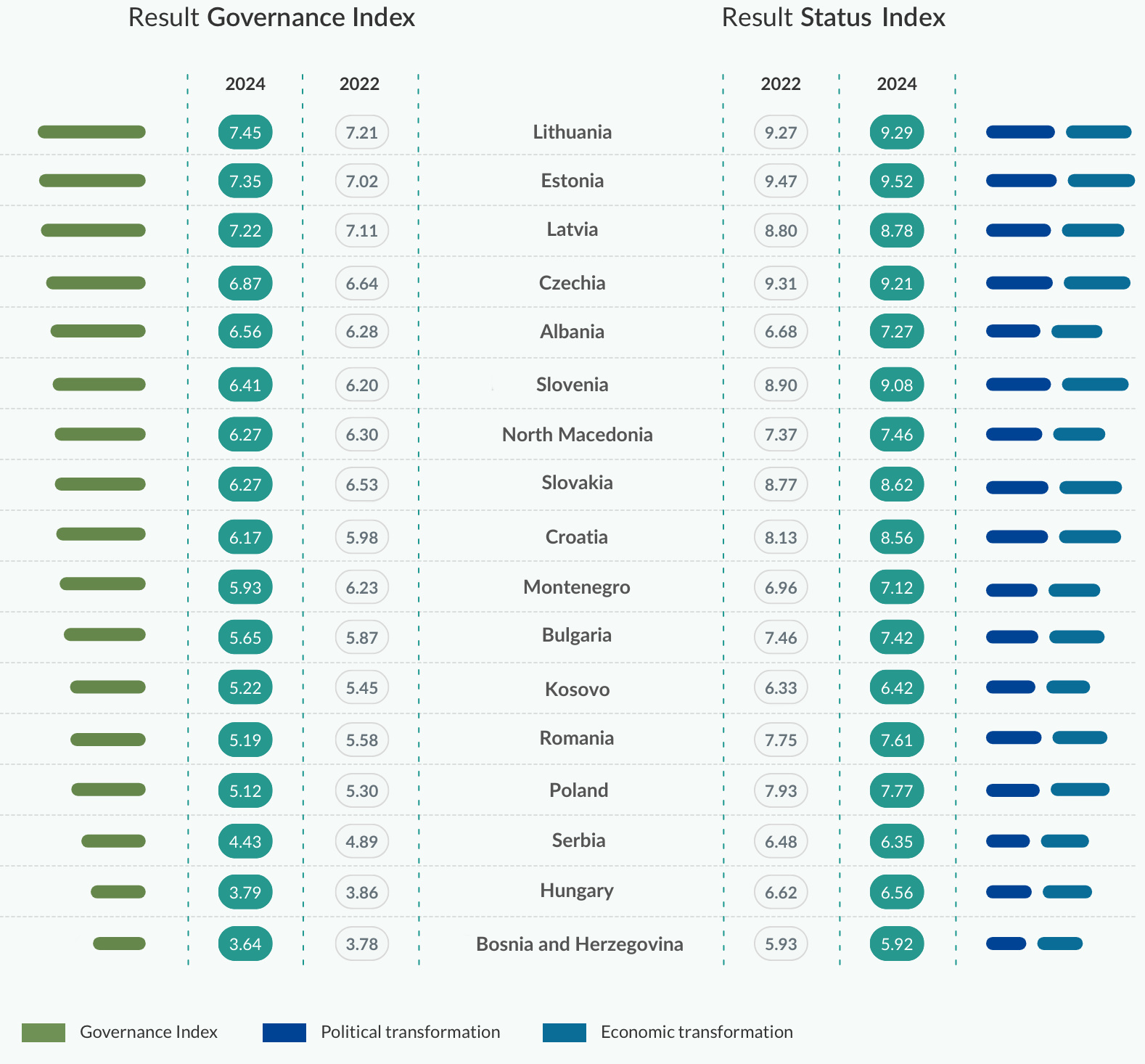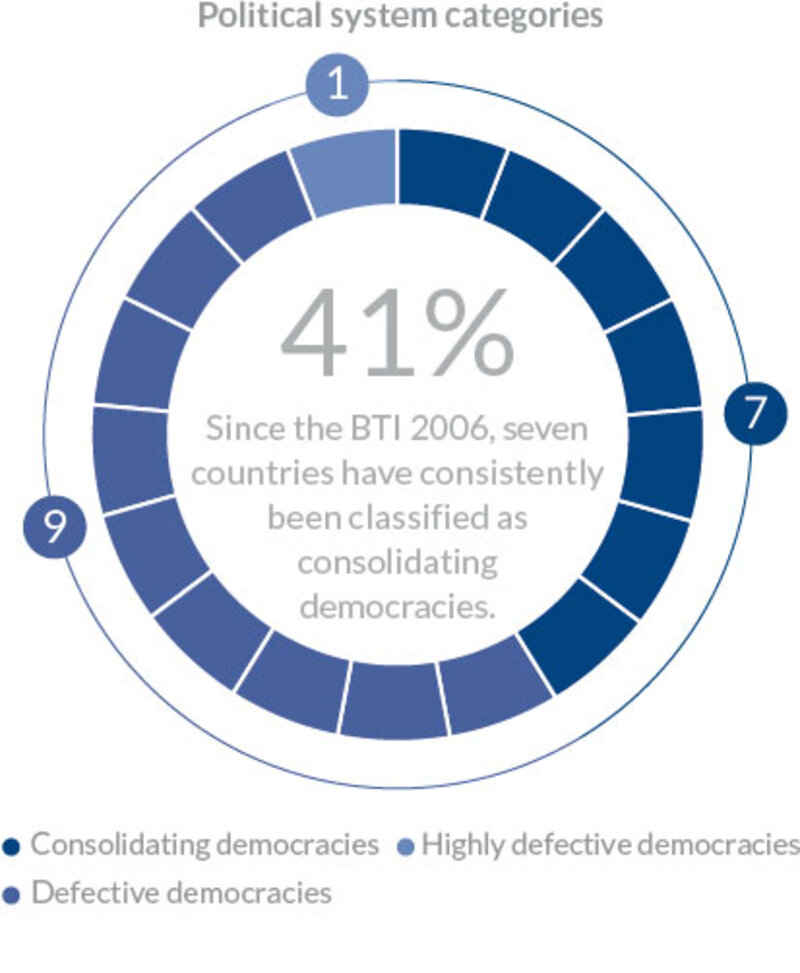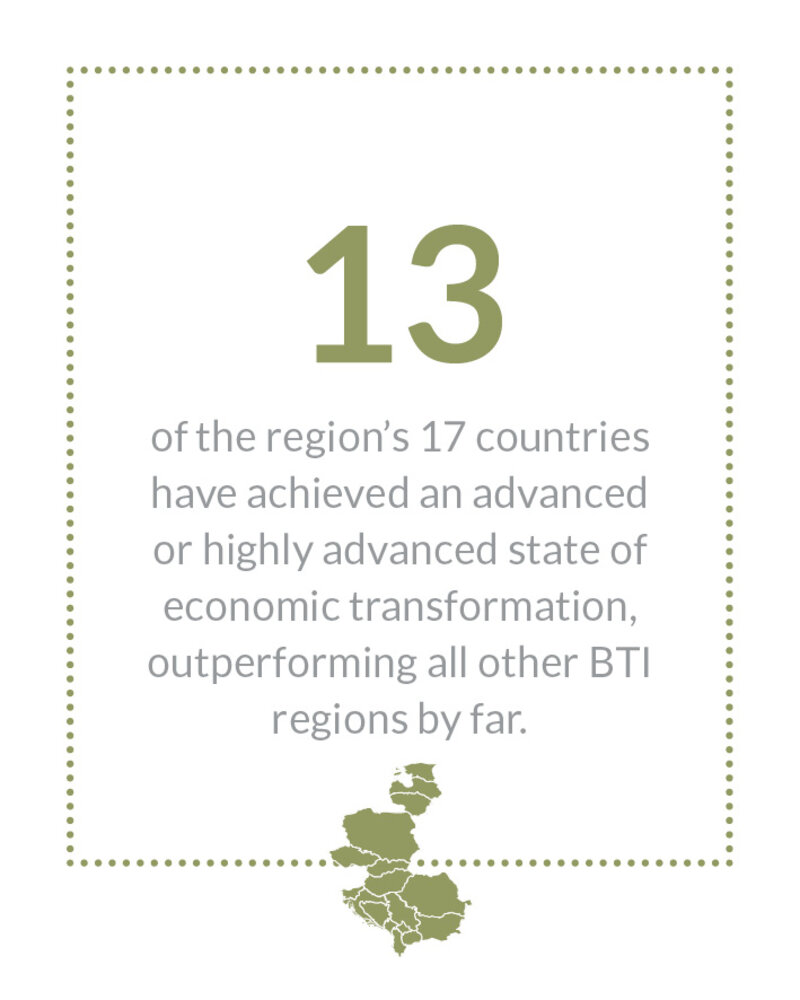Illiberal Drift Loses Some of Its Momentum
Since the BTI 2012, the regional average for transformation in East-Central and Southeast Europe has been on a near-continuous decline. This trend has been halted, with EU accession candidates Albania and North Macedonia demonstrating impressive progress. Nevertheless, events further east will continue to have a major impact on future developments in the region.
Since Russia’s full-scale invasion of Ukraine, the countries of East-Central and Southeast Europe have found themselves in the shadow of a war that is likely to have lasting impacts on their transformation trajectories. In the short term, most of the region’s countries have grappled with an intensifying polarization in domestic politics while tensions between some states have escalated. Notably, Hungary and other NATO members have clashed over support for Ukraine, and long-standing hostilities between Kosovo and Serbia continue to flare up.
Economically, most countries in the region have rebounded from the pandemic-induced downturn. However, they have had to contend with mounting state debt and budget deficits, which have been compounded by rising inflation and interest rates as well as the pressing need to diversify energy supplies and invest in renewable energies.
In terms of governance, corruption and an eroding political consensus continue to pose significant challenges in most of the region’s countries while the EU’s influence across the region is changing somewhat. On the one hand, some Western Balkan countries have seen their prospects for EU accession brighten. Despite delays in their negotiations with the EU, Albania and North Macedonia have made the biggest leaps among all countries in the region in their democracy status score over the past decade. Meanwhile, Hungary’s and Poland’s disputes with the EU persist. Overall, however, the illiberal drift underway since 2012 has lost some of its momentum. East-Central and Southeast Europe remains the leading region in the BTI – and the only one without an autocracy.
Political transformation
The struggle for stability
In this edition of the BTI, Albania, Croatia and North Macedonia have reached their highest level of democratization in a decade, and Kosovo is also once again edging toward its best score. For both Albania and North Macedonia, the initiation of EU accession negotiations in 2022 marked a significant milestone. Albania particularly improved its record on the rule of law and the stability of democratic institutions, which are key conditions for joining the EU. In the country’s 2021 parliamentary elections, the Socialist Party (PS) led by long-serving Prime Minister Edi Rama maintained its share of seats (74 out of 140). The government continued to carry out the far-reaching judicial reform launched in 2016, expanding the vetting of judges and intensifying investigations into high-level corruption cases, such as by establishing new oversight bodies. The newly elected president, Bajram Begaj, a retired military officer, has proved to be less biased than his predecessor, Ilir Meta.
North Macedonia has made impressive gains in terms of political transformation. Since the dramatic downfall of longtime Prime Minister Nikola Gruevski in 2016, the country has improved its Democracy Status score by 1.30 points. North Macedonia has admittedly made significant strides in establishing well-functioning democratic institutions and promoting freedom of expression as well as initiating legal proceedings against several high-rank- ranking officials for abuse of power. Nevertheless, it still faces several challenges related to state identity and interpersonal trust, which have been exacerbated by political instability stemming from the ruling Social Democratic Union’s setbacks in the 2021 local elections. Neighboring Kosovo has also made steady progress over the past six years and appears to have paved the way for greater stability with the clear electoral victory of former Prime Minister Albin Kurti’s Self-Determination Movement (LVV) in February 2021. Croatia (+ 0.50) has also benefited from its relative stability, even though it faced numerous corruption scandals within the center-right coalition government, including the arrest of a sitting minister.
In Slovenia, the 2022 parliamentary elections ushered in a shift from the authoritarian-leaning government of Janez Janša to the progressive government of Robert Golob. Golob’s Freedom Movement party, founded only in January 2022, secured a near majority by winning a record 41 out of 90 seats in the National Assembly. However, Golob’s rise underscores the political volatility that Slovenia has experienced since 2011. In fact, the 2022 parliamentary elections were the fourth time in a row that either a newly formed party emerged victorious, or its leader was catapulted into the position of prime minister. Czechia witnessed increasing polarization and political mobilization in addition to the electoral defeat of populist Andrej Babiš in the 2023 presidential elections. Former Prime Minister Babiš was defeated by Petr Pavel, a former general and chairman of the NATO Military Committee.
By contrast, increasingly authoritarian leaders in Hungary, Serbia and – until the October 2023 elections – Poland have consolidated their power. This is particularly striking given the fact that Eurobarometer polls conducted in February 2023 show that respondents in Poland and Hungary continue to express strong support for democracy and above-aver-average level of trust in the EU.
Economic transformation
The debt burden - how high is too high?
Economically, East-Central and Southeast Europe could not have witnessed two more radically different years. In 2021, many of the region’s economies bounced back from the pandemic’s effects, with some even achieving double-digit growth rates. However, 2022 saw soaring inflation driven in large part by Russia’s invasion of Ukraine and its impact on energy prices.
The region’s strongest performers in terms of economic transformation for the BTI 2024 – Albania (+0.79), Croatia (+0.61) and Montenegro (+0.32) – also enjoyed some of the region’s highest GDP growth rates, with the latter two particularly benefiting from the recovery of their tourism sectors once the pandemic-related travel restrictions were lifted. In January 2023, Croatia became the latest country to join the eurozone, having met the convergence criteria related to inflation and budget deficits but not the debt criteria, as an exemption was made in light of the pandemic.
Across the region, public debt and budget deficits are posing long-term challenges, which in turn are being exacerbated by rising inflation and interest rates. While most countries have maintained a low public debt burden (44.1 % of GDP in 2019) that was well below the EU average (77.7%), this average increased to 48.6 % by 2022. Given rising interest rates, servicing this debt could pose future challenges for many countries in the region. However, Montenegro’s success with managing its debt could point the way forward, as it managed to reduce its massive debt (107.4 % in 2020) to a much more manageable 71.3 % by 2022 while also strengthening its social safety nets.
Aiming to achieve fiscal stability, several countries in the region have introduced German-style “debt brake” rules. Most recently, following IMF recommendations, Serbia placed tighter limits on government spending at the end of 2022. However, since higher inflation rates and energy price hikes typically hit households already at risk of poverty the hardest, increasing government spending is sometimes not only politically expedient but also necessary. This can be seen in the example of Bulgaria’s decision to index social transfers for the country’s poorest.
Poland (–0.21), Slovakia (–0.14) and Czechia (–0.11) suffered the sharpest declines in the economic transformation dimension, with falling fiscal stability scores being largely responsible for the downgrade in all three countries. While there may have been sound reasons, including exogenous shocks, for governments across the region to have increased public spending, they generally did so without careful consideration of the long-term impacts, particularly with regard to budgetary stability. For example, both the Polish and Slovak governments actively sought to tweak the institutional mechanisms of fiscal responsibility. Poland also struggled with environmental issues and weak protections of private enterprise as the government attempted to “re-Polonize” the media and banking sectors after having defined them as strategic sectors.
Lastly, a major challenge for most countries in the region has been to finally become independent of Russian natural gas. At the beginning of 2021, more than 50 % of the natural gas that the region consumed came from Russia, but this figure had dropped below 13% by the end of 2022. In this case, Czechia is a prime example of a country that had been entirely dependent on Russian gas but nevertheless managed to cover 96 % of its needs with other energy sources, including LNG and renewables, by January 2023.
Governance
The difficulty of dealing with anti-democratic actors
Despite a consistent downward trend in the Governance Index since the BTI 2006, which is sharper than that recorded in other BTI regions, East-Central and Southeast Europe still clearly outperforms all other BTI regions in this regard. However, only the three Baltic states are classified as having “very good” governance. Meanwhile, the quality of governance in three of the region’s EU member states – one of which is characterized by chronically weak governance (Romania) and two of which feature autocratic tendencies (Poland and Hungary) – is classified as “moderate.” The latter two are also among the countries where consensus-building, which is already a weak point in the region, has suffered the most over the past decade.
In the short term, however, most score changes in individual countries have been generally limited in scope. Positive exceptions here include Estonia (+0.34) and Albania (+0.28). The former, which had been the region’s top performer in the Governance Index from the BTI 2008 to the BTI 2020, lost its lead after the far-right Estonian Conservative People’s Party (EKRE) joined the governing coalition in 2019. The situation has stabilized since the EKRE was booted from government in early 2021, and Estonia has moved back up in the ranking, to second place. Prime Minister Kaja Kallas has been active in shaping the Western response to Russian aggression in Ukraine, and post-EKRE government coalitions have aligned with the European mainstream on issues such as climate change and same-sex partnerships. In Albania, the opening of EU accession negotiations in July 2022 has revitalized reform efforts. However, many of these reforms remain a work in progress, and the fact that they are often driven by the international community and EU accession requirements results in a lack of local ownership.
Significant declines in governance quality scores were observed in Serbia (–0.45), Romania (–0.39), Montenegro (– 0.30) and Slovakia (– 0.27). Despite its more than 15 years of EU membership, Romania’s governance remains plagued by half-baked reforms, ineffectual processes and state capture by private interests. In addition, since the government continues to overly depend on EU recommendations when it comes to prioritizing important measures, it conveniently points its finger at Brussels whenever these measures fail or prove unpopular. While Montenegro has launched investigations into alleged corruption and organized crime, it’s unclear just how committed the country is to combating these problems in a sustained manner. The country’s technocratic leadership has faltered by acting inconsistently in coordinating key EU integration measures, letting comprehensive electoral reform stall and building the landmark “Europe Now” reform agenda on what some criticize as an unsound analysis. Civil society also laments the fact that it is provided few or only token opportunities to participate in decision-making processes.
In Serbia, anti-democratic forces effectively rule the country, as President Aleksandar Vučić has amassed all power, often in violation of the constitution, and other nationalist and extremist organized groups are only allowed to exist at the whim of the regime. Vučić alternatively prevents and provokes potential cleavage-based conflicts, depending on whether they advance his goals. The regime also remains ideologically and personally rooted in the era of Slobodan Milošević. While Slovakia performs much better overall, a solid consensus on democratic values gradually collapsed after the 2020 elections, partly due to the government’s incompetence and focus on short-term popularity.
Outlook
One of the shared and acute challenges for governance across the region has been the response to the war in Ukraine. The Baltic states and Poland, in particular, have led the charge for a strong rebuke to Russia, providing support for refugees and Ukraine’s civilian population as well as the maximum in terms of military assistance. Most other countries in the region have aligned themselves with the EU and NATO approach.
A clear Ukrainian victory in this war could raise hopes of EU accession among Western Balkan countries, especially Albania and North Macedonia and possibly also Montenegro. Although these countries are technically “behind” Serbia in their negotiations, their actual eagerness to join appears to be higher. The waning appeal of Russia as an ally could have transformative potential for reforms in other Western Balkan countries and even in Hungary. However, without a complete liberation of Ukraine, Russia is likely to retain significant appeal in some corners of the region. For example, this could further exacerbate tensions in Bosnia and Herzegovina. And it could add a spark to another powder keg, namely, the smoldering unresolved issues between Serbia and Kosovo.
The effects of the war are likely to be felt even if it ends quickly. Energy price increases and a higher risk of poverty are only the beginning. They come at a time when there is an urgent need to boost defense spending and invest massive amounts into diversifying energy sources. In addition, many countries – most of them warmly – have taken in a very large number of Ukrainian refugees, although they could become pawns in the hands of politicians. Nonetheless, despite a few dark clouds on the horizon, some of the region’s countries have achieved a degree of stability that can serve as inspiration for their neighbors.



